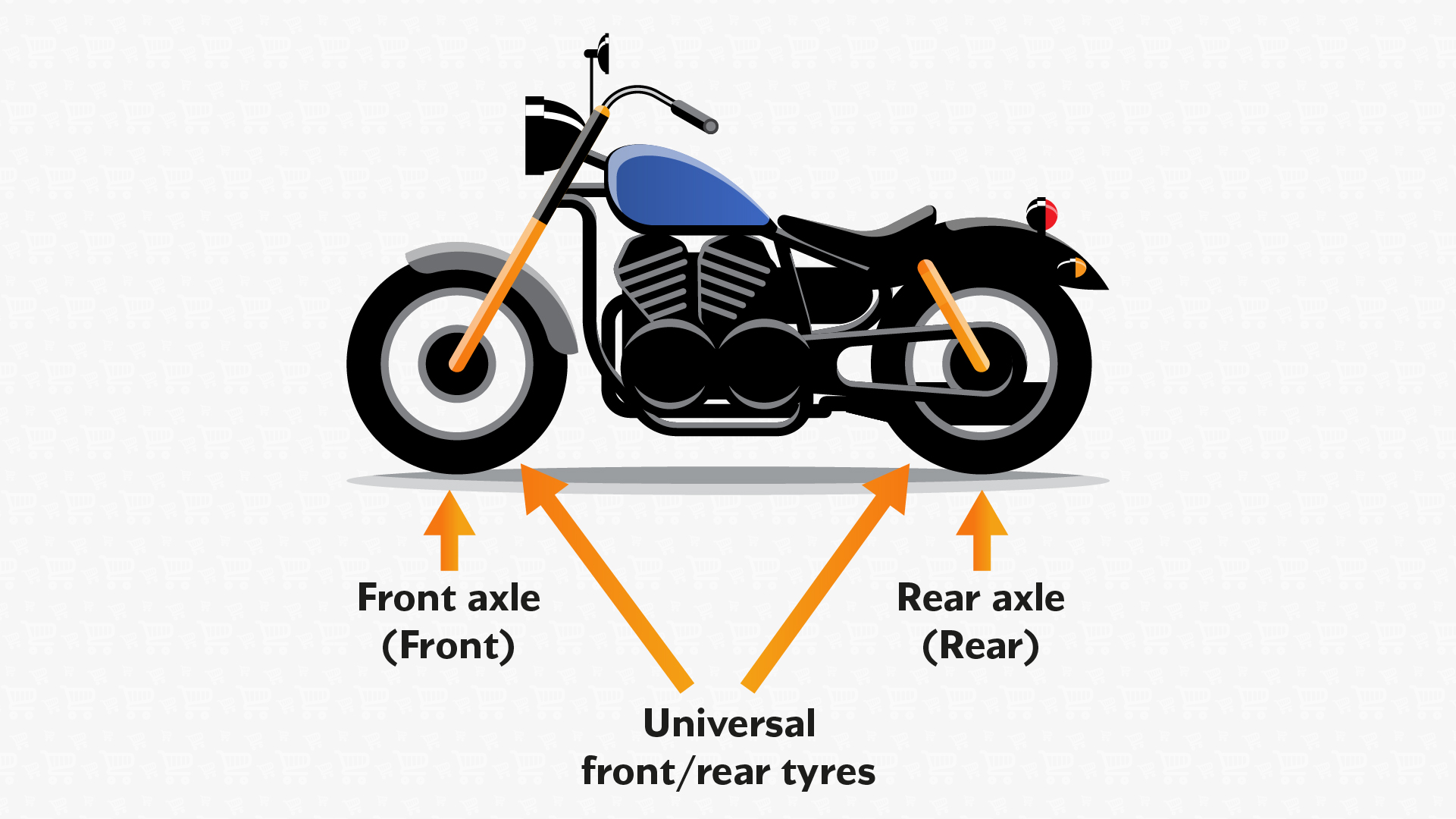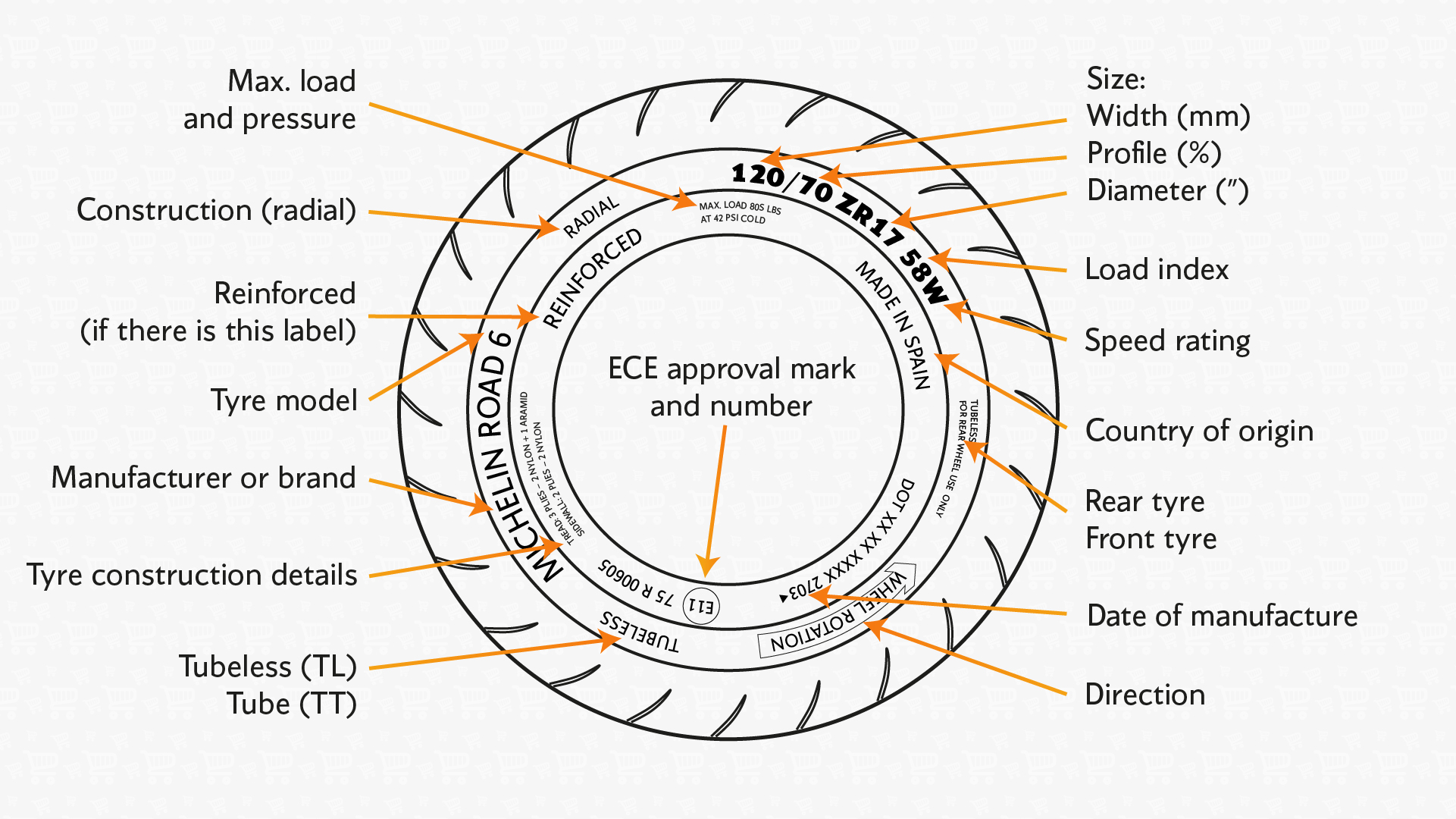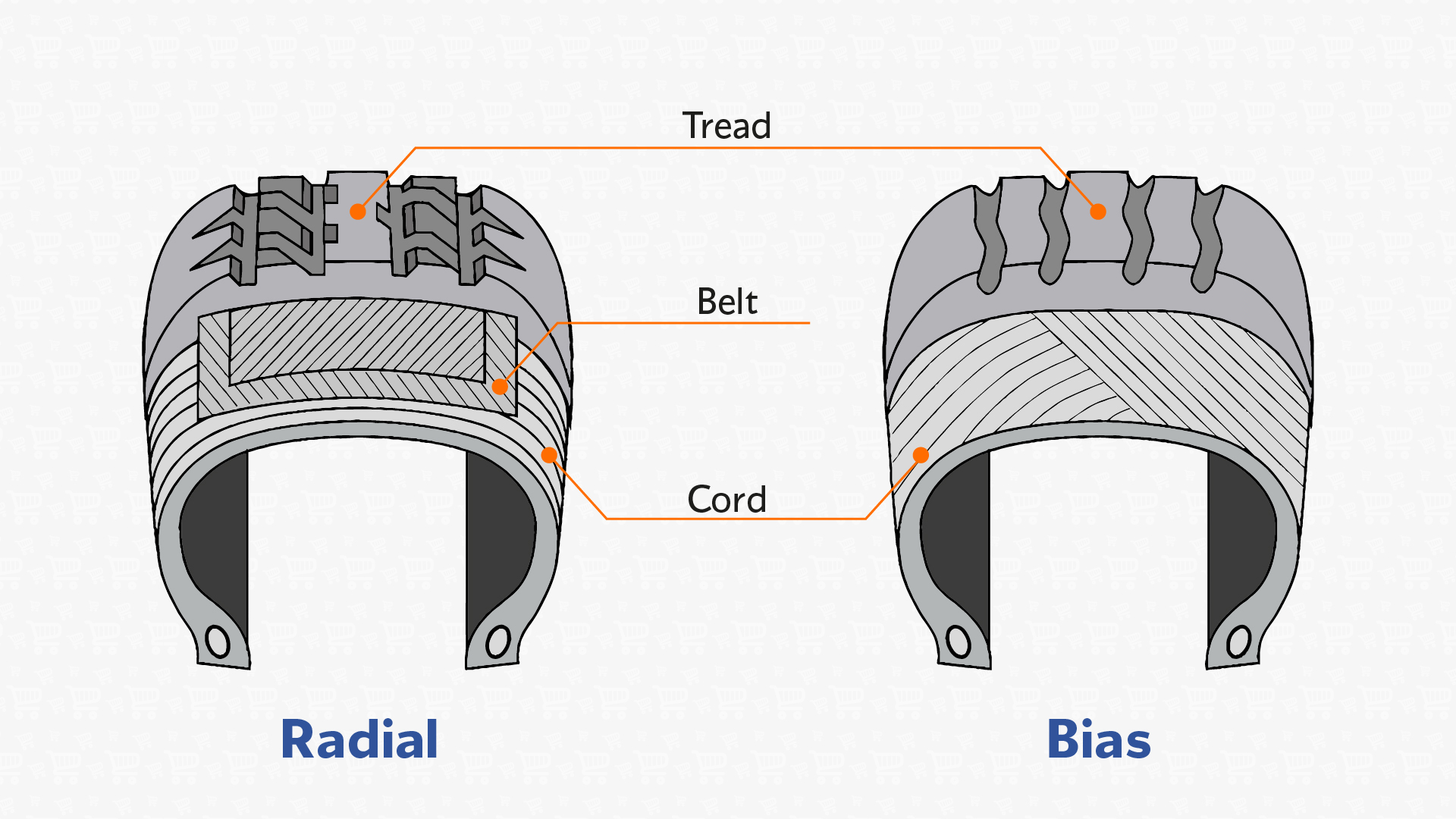Motorcycle tyres marking

Motorcycle tyres are responsible for the safety of riding. Therefore, it is not enough that the tyres physically fit the motorcycle. It is important to consider the intended usage of the tyres, the installation place, size, load index and speed rating, year of manufacture and other factors. But let's deal with everything in order.
First you need to determine for what conditions of riding a motorcycle tyres are purchased. In mass segment, road and sports motorcycle tyres, enduro and adventure class models are produced. So-called slicks are sharpened purely for racing tracks, and cross-country motorcycle tyres are suitable for conquering off-road.
Classification according to axle
An important role in choosing the right motorcycle tyres is played by the axle of a tyre. The axles of the motorcycle differ markedly in the features of operation and the specifics of the loads on the tyres. According to the installation place, motorcycle tyres are classified into the following subcategories:
- F (Front Wheel) – tyres on the front axle of motorcycle; their design takes into account the specific loads that the tyre is subjected to when turning the steering wheel;
- R (Rear Wheel) – tyres on the rear axle of the motorcycle; the accents in such models are placed on a large weight load and improved transmission of traction and braking forces – the rear wheel of a motorcycle in the vast majority of cases is the leading one;
- universal front/rear tyres can be installed on any axle of the vehicle; separate markings for universal models are not indicated; usually, this subcategory includes tyres for light motorcycles with a small engine volume, mopeds and scooters.
 |
| According to axle, motorcycle tyres are front, rear and universal. |
Metric tyre marking system
The metric system follows the traditional canons of designations for motorcycles tyre products. At its core, it follows the principles described in the article "Marking tyres from A to Z".
 |
| A visual representation of key motorcycle tyre size parameters. |
So, let's take some model as an example
120/70 ZR17 58W
- 120 – tyre tread band width in millimeters;
- 70 – profile (aspect ratio) as a percentage of the width; it is important that this parameter is measured in percentages, not in millimeters; for our example, it is equal to 120 ⋅ 0.7 = 84 (mm);
- Z – the designation of high-speed motorcycle tyres that can be used at speeds over 240 km/h;
- R – radial construction of the tyre;
- 17 – rim diameter in inches;
- 58 – load index; to decipher it, a special table is used, which is given in the corresponding section further down the text; in this case, the index "58" corresponds to 236 kg of weight per wheel;
- W – speed rating; this parameter is also determined by special tables; the “W” index marks motorcycle tyres designed for speeds up to 270 km/h.
 |
| Deciphering the key designations on the sidewall of motorcycle tyres. |
The metric system, although taken as a basis, is by no means the only one. Less common are alternative ways to label motorcycle tyres.
Alternative tyre markings
Alpha system
This system is used to designate the parameters of tyre installed on the touring motorcycles wheels. Let's consider this marking on the following example.
MR80S-17
- M (Motorcycle) – tyres for motorcycles;
- R – section width in inches; the parameter has a tabular value, in this case it is 4.5 inches;
- 80 – tyre profile (aspect ratio);
- S – speed rating; its interpretation is given in special tables and corresponds to the speed ratings of the metric system; in this case, the index S indicates the maximum speed of movement up to 180 km/h;
- 17 – rim diameter in inches.
| Value | Section width | Value | Section width |
|---|---|---|---|
| G | 2.75" | P | 4.25" |
| H | 3.00" | R | 4.50" |
| J | 3.25" | S | 4.75" |
| L | 3.50" | T | 5.00" |
| M | 3.75" | U | 5.50" |
| N | 4.00" | V | 6.00" |
Standard inch system
Tyres were labeled according to this system until 1999. In today's market, such models are very rare. Let's take a look at an example:
3.25H-19
- 3.25 – section hight and width in inches (the values are the same – it is assumed that the tyre profile is square);
- H – speed rating from the table (the letter of the Latin alphabet "H" corresponds to the speed of movement up to 210 km/h);
- 19 – rim diameter in inches, which determines the possibility of installing tyre on the rim.
Low profile inch system
For tyres whose section height is less than the width of the tread band, it was customary to use a low-profile inch marking system:
4.50/85U-18
- 4.50 – section width, expressed in inches;
- 85 – aspect ratio ratio of the sidewall height to the width (85% of 4.50 inches);
- U – speed rating from the table (letter "U" is for a value up to 200 km/h);
- 18 – tyre rim diameter in inches.
Construction type
Tyres for motorcycles can have a radial or bias design. The differences between them lie in the method of weaving the lower layers of the carcass.
In radial tyres, which are usually marked with the letter of the Latin alphabet R, textile threads run perpendicular to the direction of the wheel – from rim to rim in a horizontal plane. It is important that they do not overlap. The main role in the design of radial tyres is played by a metal cord belt as the top layer, characterized by excellent thermal conductivity and low extensibility. Radial tyre holds its shape better and is suitable for high-speed riding. In the tread area, it has increased resistance to damage and punctures. Among the shortcomings, it is worth noting the low indicators of loads, as well as the poor suitability of the radial design for full-profile tyres.
 |
| Tyres of radial and bias design differ from each other in the ways of cord weaving. |
Bias tyres are mainly designed for road and motocross motorcycles with high demands on loading. The cord in their design is overlapped – crosswise diagonally relative to the direction of the wheel. There are always an even number of layers in the carcass of bias tyres(usually four). Such tyres are better suited for off-road driving (it effectively softens impact loads), the sidewalls of bias tyres are more durable, and they are also cheaper. The reverse side of the coin of tyres of this design is that under loads they are subject to deformation and collapse, which worsens traction, and bias models are more susceptible to heat and are poorly suited for high speeds.
For marking motorcycle bias tyres, it is customary to use the “–” icon or the letter B. Unlike traditional car tyres, where the almost complete dominance of radial tyres is found, bias models are still common in the motorcycle tyres category.
Load index and speed rating
The load index of a motorcycle tyre is the maximum weight per wheel at which the tyre retains its driving properties, taking into account the recommended pressure inside. A tyre pressure label is usually placed on the motorcycle frame, and these parameters are also indicated in the motorcycle manual. Note that the load capacity value should not be lower than the actual load, but it is better to select tyres with a margin for this index. Otherwise, the operation of the tyre will be unsafe. For the rear wheel of the motorcycle, the load is often higher than for the front.
Specific values of the load on the tyre and the maximum allowable pressure in it can be written in the form of MAX LOAD 236 KG and 290 kpa (42 psi) cold(the latter parameter is indicated for a “cold”, i.e. unheated tyre)
The load indices are calculated according to the table:
| Value | Max. load, kg | Value | Max. load, kg | Value | Max. load, kg |
|---|---|---|---|---|---|
| 50 | 190 | 71 | 345 | 92 | 630 |
| 51 | 195 | 72 | 355 | 93 | 650 |
| 52 | 200 | 73 | 365 | 94 | 670 |
| 53 | 206 | 74 | 375 | 95 | 690 |
| 54 | 212 | 75 | 387 | 96 | 710 |
| 55 | 218 | 76 | 400 | 97 | 730 |
| 56 | 224 | 77 | 412 | 98 | 750 |
| 57 | 230 | 78 | 425 | 99 | 775 |
| 58 | 236 | 79 | 437 | 100 | 800 |
| 59 | 243 | 80 | 450 | 101 | 825 |
| 60 | 250 | 81 | 462 | 102 | 850 |
| 61 | 257 | 82 | 475 | 103 | 875 |
| 62 | 265 | 83 | 487 | 104 | 900 |
| 63 | 272 | 84 | 500 | 105 | 925 |
| 64 | 280 | 85 | 515 | 106 | 950 |
| 65 | 290 | 86 | 530 | 107 | 975 |
| 66 | 300 | 87 | 545 | 108 | 1000 |
| 67 | 307 | 88 | 560 | 109 | 1030 |
| 68 | 315 | 89 | 580 | 110 | 1060 |
| 69 | 325 | 90 | 600 | 111 | 1090 |
| 70 | 335 | 91 | 615 | 112 | 1120 |
The speed rating of a motorcycle tyre contains information about suitability for high speeds. The index determines at what maximum speeds the tyre retains grip, strength and stability. The estimated maximum speed at which the tyre is supposed to be used can be determined from the table values:
| Value | Max. speed, km/h | Value | Max. speed, km/h |
|---|---|---|---|
| A | 40 | Q | 160 |
| B | 50 | R | 170 |
| C | 60 | S | 180 |
| D | 65 | T | 190 |
| E | 70 | U | 200 |
| F | 80 | H | 210 |
| G | 90 | V | 240 |
| J | 100 | W | 270 |
| K | 110 | Y | 300 |
| L | 120 | VR | >210 |
| M | 130 | ZR | >240 |
| N | 140 | (W) | >270 |
| P | 150 | Z | >300 |
Tube and tubeless tyres
A significant role in the marking of motorcycle tyres is played by the designations of tube and tubeless types of tyres:
- TL (TubLess) – tubeless models that hold air directly in the space between the wheel and the tyre;
- TT (Tube Type) – tyres with a separate inner tube, which is filled with air under pressure; tube tyres are suitable for spoked wheels, however, such models are more sensitive to punctures, more difficult to repair and less reliable than tubeless counterparts;
- TT/TL – universal models that can be installed with or without a tube.
Additional designations
One of the most important secondary markings of motorcycle tyres is the date of manufacture. It is indicated by four numbers in a row (often enclosed in an oval). Behind the first two digits of the designation is the week of manufacture of the tyre, the last two digits indicate the year of production. For example, a model labeled 3522 was manufactured on the 35th week of 2022.
When choosing motorcycle tyres, it is advisable to give preference to newer rubbtyreser, released up to one year ago at the time of purchase. Stale tyres lose proper elasticity and can develop a web of microcracks, signs of aging that degrade the rubber's performance.
 |
| A motorcycle tyre marked with the date of manufacture "3719" was released in the 37th week of 2019. |
On the sidewall of tyre with a directional tread pattern, it is customary to apply an arrow with the signature Rotation, which determines the wheel rotation. Incorrect installation of such tyres can cause a decrease in handling and deterioration of traction. Non directional tyres ND (Non Directional) are placed on the wheels without regard to the rotation.
For what conditions the motorcycle tyre is created and what design features it has, you can find out from the following markings:
- SAG (Super All Grip) – tyres with improved off-road capability;
- NHS (Non Higway Service) – tyres not designed for high-speed roads;
- SL (Limited Service) – limited use of the tyre;
- XL (Extra Load) – models with resistance to increased loads;
- RF, REINF (Reinforced) – reinforced tyres with additional cord layers;
- MBS (Metzeler Belt System) – models with a special type of cord made of Kevlar threads, designed to limit tyre deformation at high speeds;
- TWI (Tread Wear Indication) – the presence of wear indicators in the tyre tread.
 |
| The tread remaining indicators allow to visually assess the degree of wear of the motorcycle tyre. |
Additional letters O, H, GL and others indicate the homologation of the tyre for a specific motorcycle model. Tyre is supposed to be used for the standard equipment of a particular motorcycle. “What are homologated tyres” is described in detail in the article of the same name.
Motorcycle tyres softness markers are given as follows:
1. RS1 (soft). 2. RS2 (medium). 3. RS3 (hard).
The white stripe on the sidewall of the tyre is designated NWS (Narrow White Stripe) and WW (White Whall). These are purely design elements that give the tyre a unique look. Fans of motorcycles in the retro style will appreciate such tyres.
Finally, it is necessary to mention the certification markings of tyre products and the standards for the production of motorcycle tyres:
E in a circle – the model is approved by the United Nations Economic Commission for Europe.
EUCX – the tyre is produced according to European standards.
DOT – the tyre complies with the safety standards set by the US Department of Transportation.
Knowing the markings makes it much easier to find the right tyres for your motorcycle. The right tyres with the right parameters are the key to safe travel, effective transfer of acceleration and braking dynamics, and the realization of the motorcycle speed potential.
Articles, reviews, useful tips
All materials




















































